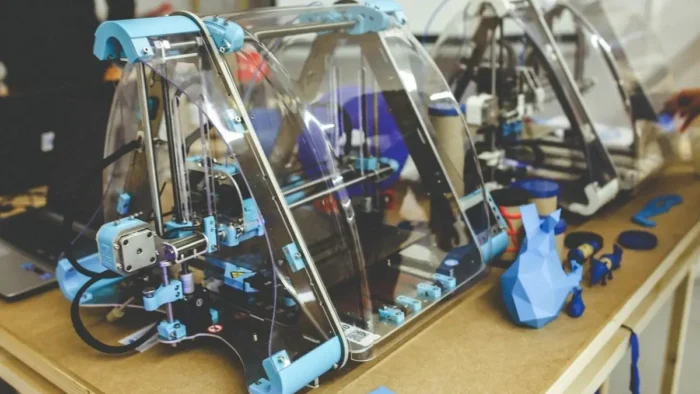We’ve been blogging about the environmental impact of 3D printing for some time now, and it’s a topic that never ceases to interest us, as we believe that achieving a manufacturing method that is increasingly environmentally friendly is one of the cornerstones of our claim that 3D printing is a new industrial revolution.
While it is true that in the above-mentioned post, we talked about wonders in this regard, and we were not the only ones who were hopeful that 3D printing service was in itself more “green” than conventional manufacturing, seeing some studies done on the subject, and since we started the year and it is time to make new and good intentions, it is also a good time to recapitulate and observe a little more closely and with a somewhat more skeptical point of view the ecological footprint of this technology (expressed as carbon footprint), based on the same points; the scale of production, the materials, and the life cycle of the products manufactured.
1. The scale of production
From the point of view of the scale of production, a Study published in September 2013 compared conventional production (considering injection moulding as such) with different 3D printers.
The hypothesis was that 3D printing would reduce the usefulness of mass production, since in the latter innovation would be constrained by economies of scale, according to which products see their price decrease as the number of units produced increases.
The calculations used for the study were made by Quantis, an agency specializing in environmental consulting located in Lausanne, Switzerland, and Boston, Massachusetts, USA, and compared three different 3D printers of different costs with production using injection molding. In addition, the study assumed other premises: as regards materials, polypropylene and polylactic acid were used for both procedures;
the standard production time is set at 50 minutes in both methods to calculate the energy cost (electricity); and mass production (production of one variant one million times) is compared with customised production (production of one million variants once).
Related: 3D Scanning: How Does It Work and What Is It Used For
The results of the study showed (see graph below) that, on the one hand, classical manufacturing is not prepared for low production volumes in terms of environmental impact; however, on the other hand, the 3D printing technique cannot compete with injection molding for high-volume production.
3D printing technologies would be, according to this study, interesting from an ecological point of view for small-scale production (less than 1000 pieces), compared to traditional injection molding technology; moreover, regardless of the quality of the 3D printer used, the environmental impact of 3D printing is lower for production volumes of less than 300 replicas. Also, depending on the scale, you need to choose between PPAP vs FAI to look at all print dimensions.
As for the additional cost of transport in centralized manufacturing, as opposed to the savings derived from building in a decentralized manner, studies coincide in the savings that 3D printing represents in this aspect.
Related: Boost Your Business Success with 3D Industrial Rendering
2. Materials and energy expenditure.
With regard to materials, in the previous article we pointed out those most used in most printers, both industrial and home, which were ABS plastic (derived from petroleum), but also bioplastics derived from corn starch (PLA).
There are many material science researchers who are continually looking for new raw materials, including pulp or wood from industrial waste, for example for use in architecture or industrial design, as I stated in this interview with Ronald Rael, or filaments from seaweed.
From an environmental point of view, resource savings come from both the selection of materials and the amount of material used in production.
In this regard, the ATKINS project, which originated some years ago (2008) by a research group from Loughborough University and was joined by other partners (including MTT Technologies, Boeing, and Bentley), aimed to analyze the environmental impact of 3D printing compared to “traditional” production.
In particular, the research was carried out on the production of metal parts with sintering processes for the automotive and aerospace sectors.
In principle, the group worked with polymers as well, but they came up against an unexpected reality; indeed, contrary to what was believed (and which we ourselves wrote in the previous article) not all polymer powder that has not been melted down to form the part in the process can be reused in subsequent parts.
However, in processes with metal, the powder can be reused, so the waste generated is much lower (as well as the material expense).
In the case of plastics, our team blog, believes that it is important for the 3D printing industry to work towards this by reusing material from failed prototypes.
To this end, there are also machines capable of recycling already used plastics, but the quality of the material decreases with each reuse cycle and is easier to break, so users are reluctant to adopt them.
Another advantage of 3D printing in terms of material savings is the production of parts without the need to create the moulds used in “traditional” production.
On the other hand, additive manufacturing can produce parts that are 50% lighter than other injection moulding techniques, which is extremely important in the automotive and space industry, as less weight translates into fuel savings during the use phase, and this in turn translates into fewer emissions, which can be in the order of four times less.
This is a remarkable aspect of both Boeing and Bentley, applicable to other luxury car brands known for their high weight and emissions.
The advantage of creating hollow, lighter parts with lower material requirements has also been described in a study by two MIT scientists.
However, both the ATKINS and MIT studies highlight that when assessing the sustainability of 3D printing, both the materials and the energy requirements of the printers must be taken into account.
In this regard, the ATKINS study found that 3D printers that use heat or an energy source (laser, UV) to melt the plastic consumed 100 times more electrical energy than traditional manufacturing to produce an object of the same weight.
Comparing the two procedures, the injection moulding produces 1000 parts per hour, while the sintering printer they used produced 100 parts per day using the same amount of energy.
The MIT study considered 3D printing advantageous only in the case of using photovoltaic cells as an energy source regardless of the material used, due to the large amount of energy needed to maintain the right temperature in the hotbed of the printer (in this case, a RepRap Mendel Prusa), which can be improved by using chemicals to promote adhesion, heating only the part of the printing platform needed, better isolating the platform, or using a camera to thermally isolate the printer.
The study also showed that higher quality printers consume more energy than low cost ones
This point is in turn related to the issue of scales and the use of renewable energies, which are key to production more in line with the environmental challenges that lie ahead.
One of the arguments often used against these sources is that they cannot provide, at a reasonable price, the amount of energy needed for the current scales of production. However, is it possible that small amounts of energy from renewable sources can be obtained and used for small volumes of production?
Another aspect of 3D printing related to both the decrease in scale of production (specifically, at the domestic or small workshop level) and environmental pollution, is the emission of particles, as read in a recent study published in a scientific journal .
Many commercially manufactured desktop printers are based on the extrusion and deposition of heated thermoplastic material, which in the printing process produce significant aerosol size emissions, called ultrafine particles (UFP) whose diameter is less than 100 nm.
These particles are important from a health point of view because they are deposited in the airways.
According to the same article, in the case of ABS plastic, gases such as carbon monoxide and cyanide from hidŕogeno, among other volatile compounds, are also generated.
This study compared the emissions from two types of office printers using two types of plastic as raw material, ABS and PLA, finding that these were high, especially in the case of ABS plastic.
However, in order not to be alarmist, it should be noted that the particulate emissions levels described were compared with another study measuring the emissions of ultrafine particles generated by cooking, and it was found that (in 3D printing with ABS) the emissions would be equivalent to those from cooking the food in a gas or electric oven at low power, and lower than those resulting from cooking it in these high power devices.
Even so, and given that these devices are sold without including accessories for adequate ventilation or filtration, the results described make it advisable to take precautions in their use, especially in poorly ventilated rooms.
On the other hand, the article concludes that further experiments using a wider range of 3D printers and materials are necessary.
3. Product life cycle and applications for environmental purposes
In the present article we have been able to see other aspects related to the life cycle; for example, the possibility of creating lighter parts affects the use of the object, for example the fuel consumption and the emissions generated by it.
In this respect, we also refer to what was mentioned in the previous article in this blog on 3D printing and the environment: the possibility of extending the life cycle of a product by being able to print a part in isolation, which we could not otherwise acquire (being forced to buy the whole product again), or by giving new uses to the products by adding 3D printed parts.
In this way, we could say that “sustainability” depends on the usefulness of this technology.
To top it all off, we could add some applications of 3D printing that are related to environmental protection and that are at the very least curious.
For example, the protection and care of wildlife, through prosthetics that allow them to continue living in freedom; or even complete ecosystems in danger, such as those of the Persian Gulf, by printing reefs that serve as a base for corals, sponges and other sessile organisms.
Or even, and returning to the subject of energy, by manufacturing photovoltaic cells and other objects that incorporate the use of solar energy, thus reducing emissions of greenhouse gases such as CO2.
And if what we want is to reduce these greenhouse emissions, we can also… print living plants, using as material a mixture of water, clay and living seeds that give rise to small gardens.



